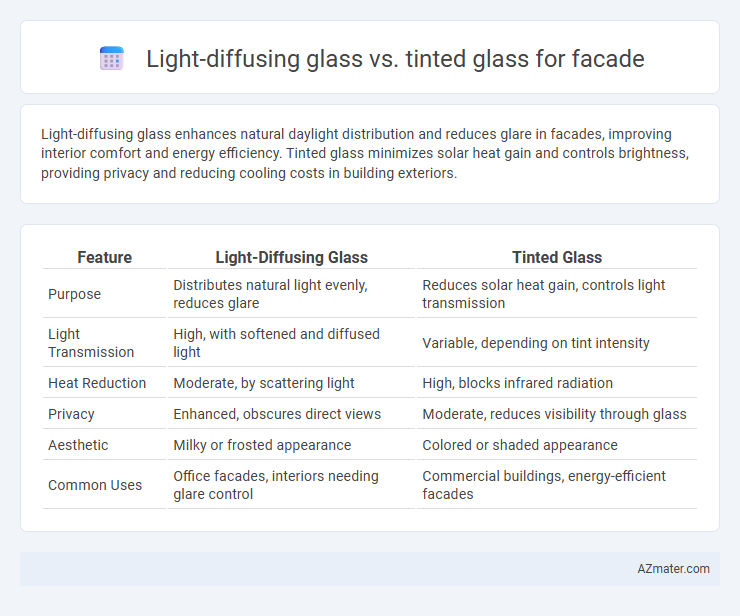Light-diffusing glass enhances natural daylight distribution and reduces glare in facades, improving interior comfort and energy efficiency. Tinted glass minimizes solar heat gain and controls brightness, providing privacy and reducing cooling costs in building exteriors.
Table of Comparison
| Feature | Light-Diffusing Glass | Tinted Glass |
|---|---|---|
| Purpose | Distributes natural light evenly, reduces glare | Reduces solar heat gain, controls light transmission |
| Light Transmission | High, with softened and diffused light | Variable, depending on tint intensity |
| Heat Reduction | Moderate, by scattering light | High, blocks infrared radiation |
| Privacy | Enhanced, obscures direct views | Moderate, reduces visibility through glass |
| Aesthetic | Milky or frosted appearance | Colored or shaded appearance |
| Common Uses | Office facades, interiors needing glare control | Commercial buildings, energy-efficient facades |
Introduction to Facade Glass Technologies
Light-diffusing glass enhances facade aesthetics by scattering natural light evenly, reducing glare and improving interior illumination without compromising transparency. Tinted glass for facades primarily controls solar heat gain and glare through color coatings or embedded materials, contributing to energy efficiency and occupant comfort. Both technologies play crucial roles in modern architectural design by balancing visual appeal, thermal performance, and daylight management.
What is Light-Diffusing Glass?
Light-diffusing glass is engineered with microscopic textures or additives that scatter incoming light uniformly, reducing glare while maintaining natural brightness within building interiors. Unlike tinted glass, which primarily reduces light transmission by darkening or absorbing sunlight, light-diffusing glass enhances visual comfort and energy efficiency without compromising daylight quality. This makes it an ideal facade material for creating balanced illumination and privacy in commercial and residential buildings.
What is Tinted Glass?
Tinted glass is a type of architectural glass that incorporates additives or coatings to reduce solar heat gain and glare by absorbing a portion of sunlight, thus improving energy efficiency and occupant comfort in building facades. Compared to light-diffusing glass, which scatters light to create uniform illumination and minimize shadows, tinted glass offers a darker appearance and increased privacy while maintaining visibility. The choice between tinted and light-diffusing glass depends on the specific design goals, climate conditions, and aesthetic preferences for the building's exterior.
Key Differences Between Light-Diffusing and Tinted Glass
Light-diffusing glass scatters incoming light to reduce glare and create an even, soft illumination, improving visual comfort inside buildings. Tinted glass primarily reduces solar heat gain and controls brightness by absorbing and reflecting sunlight, which also enhances privacy and reduces fading of interior furnishings. While light-diffusing glass optimizes natural light distribution, tinted glass focuses more on energy efficiency and heat control for building facades.
Energy Efficiency Comparison
Light-diffusing glass enhances energy efficiency by evenly dispersing natural light, reducing the need for artificial lighting and minimizing heat gain through controlled solar transmission. Tinted glass lowers cooling loads by absorbing and blocking a significant portion of solar radiation, but can reduce daylight penetration, potentially increasing reliance on electric lighting. Selecting between the two depends on specific facade performance goals, with light-diffusing glass excelling in balanced daylight utilization and tinted glass excelling in solar heat rejection.
Impact on Interior Lighting and Comfort
Light-diffusing glass enhances interior lighting by evenly dispersing natural light, reducing glare and creating a softer, more comfortable ambient environment. Tinted glass primarily controls solar heat gain and reduces brightness by darkening incoming light, which can limit daylight penetration and potentially increase the need for artificial lighting. Choosing between light-diffusing and tinted glass impacts energy efficiency and occupant comfort, with light-diffusing glass promoting balanced daylight distribution and tinted glass providing heat and glare control.
Visual Aesthetics and Architectural Appeal
Light-diffusing glass enhances facade aesthetics by evenly scattering natural light, creating a soft, glowing appearance that reduces glare and improves interior comfort while maintaining privacy. Tinted glass offers a sleek, reflective surface that provides a modern, dramatic look by controlling solar heat gain and reducing brightness, but can sometimes appear darker or less inviting. The choice between light-diffusing and tinted glass significantly impacts the building's visual appeal, with light-diffusing glass favoring a more organic, luminous effect and tinted glass emphasizing boldness and energy efficiency.
Thermal Performance and Solar Control
Light-diffusing glass enhances thermal performance by scattering sunlight to reduce glare and evenly distribute natural light, lowering cooling loads in building facades. Tinted glass improves solar control by absorbing and reflecting a significant portion of solar radiation, thereby reducing heat gain and improving energy efficiency. Both types offer distinct benefits, with light-diffusing glass optimizing daylight management and tinted glass providing stronger solar heat gain reduction.
Sustainability and Environmental Benefits
Light-diffusing glass enhances natural daylight distribution in building facades, reducing the need for artificial lighting and lowering energy consumption, which contributes significantly to sustainability. It minimizes glare and maintains thermal comfort, improving occupant well-being while optimizing HVAC efficiency. Tinted glass reduces solar heat gain, cutting cooling loads and energy costs, but may limit daylight penetration, potentially increasing reliance on artificial lighting and affecting energy savings.
Choosing the Right Glass for Your Facade
Light-diffusing glass enhances natural daylight distribution, reducing glare and creating a softer, more uniform interior illumination ideal for energy-efficient facades. Tinted glass minimizes solar heat gain and increases privacy by absorbing and reflecting sunlight, making it suitable for facades in hot climates or urban environments. Selecting the right glass depends on balancing daylight control, thermal performance, aesthetic preferences, and the building's geographic location.

Infographic: Light-diffusing glass vs Tinted glass for Facade
 azmater.com
azmater.com